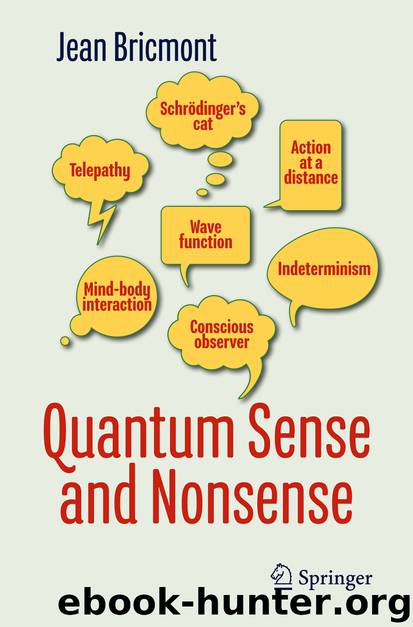Quantum Sense and Nonsense by Jean Bricmont

Author:Jean Bricmont
Language: eng
Format: epub
Publisher: Springer International Publishing, Cham
8.3.1 “Measurements” of Velocities in the de Broglie–Bohm Theory
The simplest example is the measurement of velocities: how does one do that? One measures the difference of the positions at two different times and one divides by the length of the time interval.6
So, measurements of velocities are in the end dependent on measurements of positions. Now consider a particle in a box, like the one we introduced in Sect. 7.2. It turns out that, in the de Broglie–Bohm theory, for many wave functions associated to a particle in a box , the particle is actually at rest: it has a well-defined velocity , but which is equal to zero! Yet, quantum mechanics predicts that results of measurements of velocities will have a probability distribution which is quite different from zero (another quantum fact that one has to accept without proof).
But how does one measure the velocity of the particle in the box? One cannot just look at it with God’s eye so to speak and see that it is at rest. One way to measure this velocity is to open the box, let the particle move and detect its position after some time. Then, one obtains its velocity , as we said, by computing the difference between the positions at the initial time and the final one and dividing by the length of the time interval.7
But, in the de Broglie–Bohm theory , opening the box changes the wave function of the particles in the box; that in turn causes the particles in the box to start to move (remember: that’s because the wave function guides the particles), and they move in such a way that, if we measure the positions of the particles after some time, and compute their velocity with the above method, we obtain results whose statistical distribution agrees with the quantum mechanical predictions.8
But this means that our “measurement of velocity” did not measure the initial velocity of the particle (which was zero!).
Note also that, unlike what Heisenberg’s inequality is often taken to mean, not only do particles have both a position and a velocity at all times, but one can know both with arbitrary precision, at least in the example of the particle in the box: indeed, we know from the de Broglie–Bohm theory, that the velocity is zero and we can, in principle, measure independently its position with arbitrary precision.
But if we “measure its velocity” by the above procedure (opening the box and measuring the position later) , then we obtain something entirely different, and if we take the size of the box as related to the “spread” of the initial positions (see Sect. 4.4) and consider the “spread” of the statistical distribution of results of what are called the “measurements of the velocities”, those two “spreads” will satisfy Heisenberg’s inequality, simply because the “measured” statistical distributions agree with the ones predicted by the quantum mechanical formalism and the Heisenberg inequality is just a mathematical consequence of that formalism.
But in the de Broglie–Bohm theory, particles do have
Download
This site does not store any files on its server. We only index and link to content provided by other sites. Please contact the content providers to delete copyright contents if any and email us, we'll remove relevant links or contents immediately.
The Complete Stick Figure Physics Tutorials by Allen Sarah(7307)
Secrets of Antigravity Propulsion: Tesla, UFOs, and Classified Aerospace Technology by Ph.D. Paul A. Laviolette(5309)
Thing Explainer by Randall Munroe(3877)
The River of Consciousness by Oliver Sacks(3538)
The Order of Time by Carlo Rovelli(3145)
How To by Randall Munroe(3033)
A Brief History of Time by Stephen Hawking(2960)
I Live in the Future & Here's How It Works by Nick Bilton(2935)
The Great Unknown by Marcus du Sautoy(2646)
What If?: Serious Scientific Answers to Absurd Hypothetical Questions by Randall Munroe(2637)
Midnight in Chernobyl by Adam Higginbotham(2483)
Blockchain: Ultimate Step By Step Guide To Understanding Blockchain Technology, Bitcoin Creation, and the future of Money (Novice to Expert) by Keizer Söze(2445)
Networks: An Introduction by Newman Mark(2360)
The Meaning of it All by Richard Feynman(2300)
Easy Electronics by Charles Platt(2281)
The Tao of Physics by Fritjof Capra(2229)
Midnight in Chernobyl: The Untold Story of the World's Greatest Nuclear Disaster by Adam Higginbotham(2177)
When by Daniel H Pink(2082)
Introducing Relativity by Bruce Bassett(2076)
